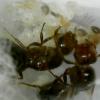Fungus seems to be a constant issue with formicariums since it combines humidity with heat and food, creating the perfect environment for fungus to grow. Keeping the formicarium clean is nearly a futile effort since ants (at least mine) are messy eaters and tend to hoarde food. Good luck trying to keep the cotton of test tubes clean. I began to wonder if there's a way to inhibit the growth of fungus and mold, especially after suspecting it may have contributed to the demise of some queens. As a hobbyist who last took biology almost 15 years ago, here are some of the solutions I think are worth exploring:
- Springtails and Fungus Gnats - Probably the primary controllers in nature. However, will be tough to maintain in a formicarium since they'll need a constant food source and will probably be eaten by the ants. Might be worth trying if you have a large, aquarium style environment.
- Sphagnum Moss - A lot of vivarium keepers recommend long fiber sphagnum as being anti-fungal. Is it the same live and dry? Is it the moss or a chemical in the moss? Or is it a bacterial the moss supports? I'm thinking of placing a small amount of sphagnum next time I use some of my THA nests that tend to have issues. What about using moss juice to hydrate the nest? Or moss juice in the end of test tubes? Or just shoving a ball of wetted moss in a tube, the queen might like digging in that...
- Bacillus subtilis - Appears to have been studied extensively for it's anti-fungal properties. Found in yogurt probiotic supplements, apparently. I wonder if seeding a nest with it would help.
- Anti-fungal Cream - Someone tried using it in their terrarium. At first I thought that's crazy, but then again, why not? Assuming it's not toxic to ants...
Actual biologists feel free to chime in and tell me I'm off my rocker! ![]()



















